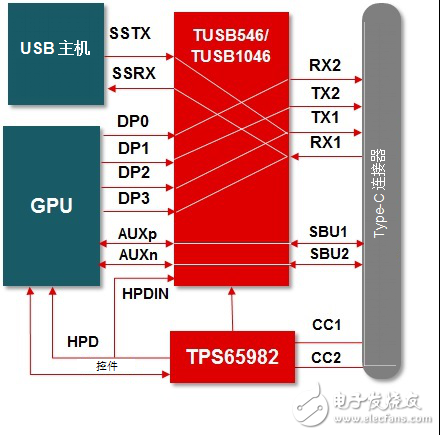USB type-c connectors can support a wide range of data and video standards, including USB and DisplayPortTM, and are increasingly used in consumer electronics. The USB type-c is based on the USB 3.1 standard and supports data transfer rates of up to 10 Gbps. At this high data rate, it is critical to maintain the signal integrity of the entire data channel in order to meet the maximum support performance of each device.
There are several factors that affect signal integrity, such as channel loss, inter-symbol interference (ISI), and signal reflection caused by impedance mismatch between printed circuit board (PCB) and transmission cable. As the signal passes through the channel, the amplitude of the signal decays, and the degree of attenuation varies with the frequency information of the signal. The longer the channel, the greater the attenuation, and at high data rates, attenuation can cause signal integrity problems.
The re-driver is a signal conditioning device. It recovers the loss of the signal on the channel and enhances the output, extending the signal's transmission distance. The re-driver has a configurable equalization function that helps recover signals that suffer from ISI and/or channel loss. The re-driver also increases the amount of DC in the recovered signal. Configurable equalizer (EQ) and DC gain also help pass system electrical performance and protocol compliance testing and enhance interoperability between devices. If the re-driver is not used, the channel transmission distance of the signal is limited.
For the USB 3.1 Gen 2 system, the USB type-c port has an insertion loss budget of 8.5 dB, plus a 6.5 dB USB type-c cable loss, and a total loss budget of 23.5 dB. This loss budget only supports USB Type-C cables of less than 1m, as well as FR4 trace lengths of only a few inches at the host and device, and the layout of the device and the design dimensions of the PCB are limited. In order to maintain good signal quality in the USB Type-C Gen 2 system while meeting PCB size and device layout without restrictions, the re-driver is the most cost-effective solution.
The Texas Instruments TUSB1046 is a VESA USB Type-C Alternate Mode Transfer Drive Switch that supports up to 10Gbps data transfer rates for downstream ports (hosts). Figure 1 is a block diagram of the TUSB1046 alternate mode system.

Figure 1: TUSB1046 alternate mode block diagram of the host
On a typical motherboard, it is difficult to place the host controller close to the USB Type-C connector, and the TUSB1046 USB Type-C re-driver with the multiplexer can solve the common signal on the motherboard. Integrity issues. At the same time, the USB Type-C multiplexer function of the TUSB1046 also enables the flipping of the connector/cable interface. The TUSB1046 supports USB 3.1Gen 2 signaling and DisplayPort 1.4 with alternate mode options such as dual channel USB, plus dual or quad DisplayPort, and other supported configurations.
Quickly evaluate your USB Type-C design with the TUSB1046 USB Type-CTM Alternate Mode Redriver Switch (TUSB1046EVM) with data transfer rates up to 10Gbps EVM.
other information· Read the white paper “USB 3.1 Channel Loss Budgetâ€.
· Download the 5Gbps Type-C Transfer Drive Multiplexer TUSB546 data sheet.
· Learn more about the TPS65982 USB Type-C USB Controller Power Switch.
Basic Physics Experiment Instrument Series
Basic physics experiment instrument series, used in physics laboratories of colleges and universities.
Basic Physics Experiment Instrument,Light And Optical Instruments,Optical Viewing Instrument,Microscope Light Source Instrument
Yuheng Optics Co., Ltd.(Changchun) , https://www.yhencoder.com